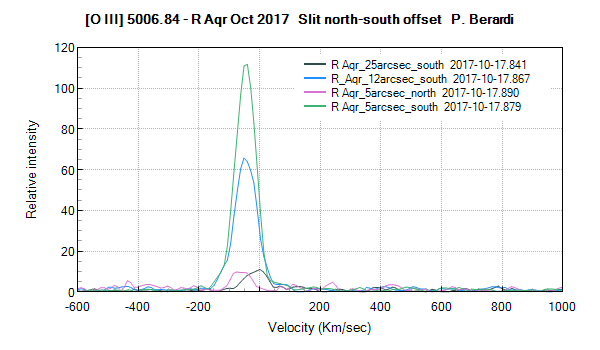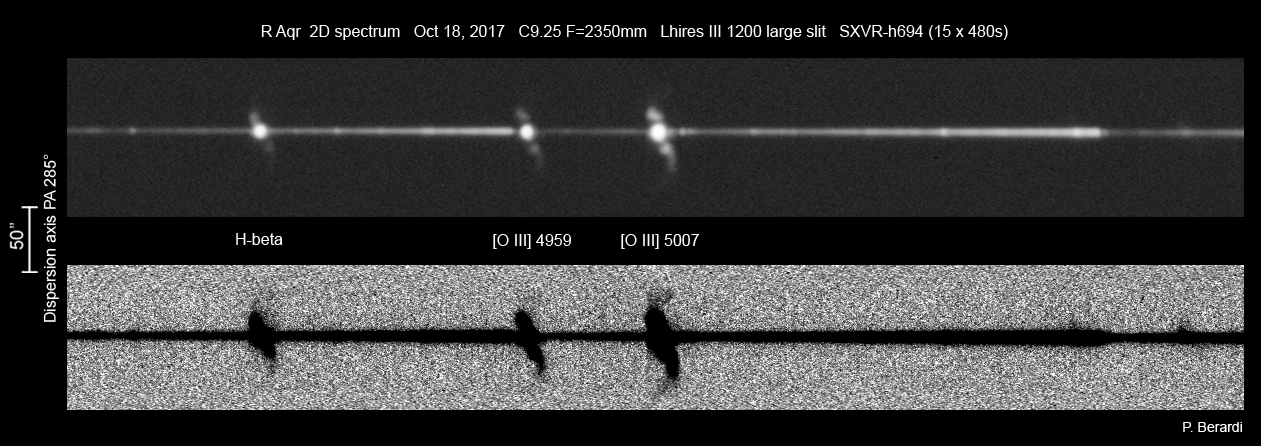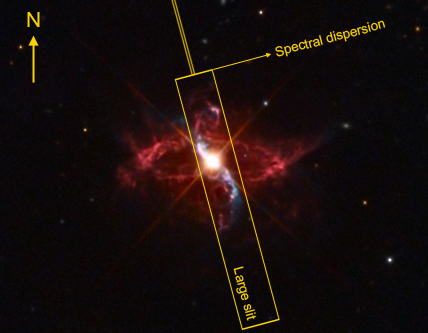R Aqr spectra requested by Margarita Korovska
-
Francois Teyssier
- Posts: 1565
- Joined: Fri Sep 23, 2011 1:01 pm
- Location: Rouen
- Contact:
Re: R Aqr spectra requested by Margarita Korovska
Good coverage for day 1
Going on daily observations until Sunday
All the best,
François
Going on daily observations until Sunday
All the best,
François
François Teyssier
http://www.astronomie-amateur.fr
http://www.astronomie-amateur.fr
-
Benjamin Mauclaire
- Posts: 258
- Joined: Thu Sep 29, 2011 10:14 am
Re: R Aqr spectra requested by Margarita Korovska
Hello,
Following request, I observed R Aqr in emission last night.
Spectra and results are available here:
http://wsdiscovery.free.fr/astronomie/s ... tics/r_aqr
R Aqr hasn't at all a stellar apparence!
Benji
Following request, I observed R Aqr in emission last night.
Spectra and results are available here:
http://wsdiscovery.free.fr/astronomie/s ... tics/r_aqr
R Aqr hasn't at all a stellar apparence!
Benji
Spcaudace spectroscopy software: saving you hundred hours of frustration.
-
Christian Buil
- Posts: 1432
- Joined: Mon Sep 26, 2011 6:59 pm
- Contact:
Re: R Aqr spectra requested by Margarita Korovska
Déjà 3 nuits d'observations sur Toulouse et en espérant que le beau temps persiste (vent d'Autan prévu = nuages en principe). Voici une quicklook de la première :


(je t'envoie les fichiers d'ici demain/après demain François)
Christian


(je t'envoie les fichiers d'ici demain/après demain François)
Christian
-
Francois Teyssier
- Posts: 1565
- Joined: Fri Sep 23, 2011 1:01 pm
- Location: Rouen
- Contact:
Re: R Aqr spectra requested by Margarita Korovska
C'est excellent Christian,
Nous répondons largement à la demande de Margarita K., avec des spectres d'excellente qualité!
Merci à tous,
Bonne continuation jusqu'à dimanche
François
Nous répondons largement à la demande de Margarita K., avec des spectres d'excellente qualité!
Merci à tous,
Bonne continuation jusqu'à dimanche
François
François Teyssier
http://www.astronomie-amateur.fr
http://www.astronomie-amateur.fr
-
Terry Bohlsen
- Posts: 191
- Joined: Thu Sep 29, 2011 7:40 am
Re: R Aqr spectra requested by Margarita Korovska
I agree it is not stellar. There is a close companion that is quite visible in the blue and a haziness visible with a U filter. See below.Benjamin Mauclaire wrote:Hello,
Following request, I observed R Aqr in emission last night.
Spectra and results are available here:
http://wsdiscovery.free.fr/astronomie/s ... tics/r_aqr
R Aqr hasn't at all a stellar apparence!
Benji
I also took a much better spectrum than my previous one as the weather was kinder.
Terry Bohlsen
Armidale NSW
Australia
Armidale NSW
Australia
-
Francois Teyssier
- Posts: 1565
- Joined: Fri Sep 23, 2011 1:01 pm
- Location: Rouen
- Contact:
Re: R Aqr spectra requested by Margarita Korovska
An update
The monitoring is perfect
It looks that we detect variations in some lines, especially H alpha at a time scale of ~ 1 day Resolution 8000 to 14000
But a word of caution: as mentionned R Aqr as a symbiotic star has a combination spectrum (hot component+red giant+nebula).
More over it is well knowned that complex jets are/have been emitted
So the observed "variations" in the profile of Ha line could be the result of observed area (setup, seeing ...)
I try to get a response and I'll keep you informed
Message from Margarita to the group :
Beautiful! Thanks all!
I got half of Chandra obs, waiting for the other half exp to be done, scheduled tomorrow:
2017:286:14:07:18.549 UT 2017:287:11:24:38.549 UT
I got HST obs , waiting for the data to get to the archive.
There are few more people getting spectra, including George Wallerstein's group.
Please continue the spectroscopy coverage.
The monitoring is perfect
It looks that we detect variations in some lines, especially H alpha at a time scale of ~ 1 day Resolution 8000 to 14000
But a word of caution: as mentionned R Aqr as a symbiotic star has a combination spectrum (hot component+red giant+nebula).
More over it is well knowned that complex jets are/have been emitted
So the observed "variations" in the profile of Ha line could be the result of observed area (setup, seeing ...)
I try to get a response and I'll keep you informed
Message from Margarita to the group :
Beautiful! Thanks all!
I got half of Chandra obs, waiting for the other half exp to be done, scheduled tomorrow:
2017:286:14:07:18.549 UT 2017:287:11:24:38.549 UT
I got HST obs , waiting for the data to get to the archive.
There are few more people getting spectra, including George Wallerstein's group.
Please continue the spectroscopy coverage.
François Teyssier
http://www.astronomie-amateur.fr
http://www.astronomie-amateur.fr
-
Christian Buil
- Posts: 1432
- Joined: Mon Sep 26, 2011 6:59 pm
- Contact:
Re: R Aqr spectra requested by Margarita Korovska
My last observations (Ritchey-Chretien 254 mm f/8, eShel(2), ASI1600MM). Detail of red part:

Tentative on the blue region by using the improved eShel:

Christian

Tentative on the blue region by using the improved eShel:

Christian
-
Francois Teyssier
- Posts: 1565
- Joined: Fri Sep 23, 2011 1:01 pm
- Location: Rouen
- Contact:
Re: R Aqr spectra requested by Margarita Korovska
Spectra obtained the same night with a good snr:But a word of caution: as mentionned R Aqr as a symbiotic star has a combination spectrum (hot component+red giant+nebula).
More over it is well knowned that complex jets are/have been emitted
So the observed "variations" in the profile of Ha line could be the result of observed area (setup, seeing ...)
I try to get a response and I'll keep you informed
Comments from Steve:
The nebula and jet are highly
structured and have complex velocity distributions. This could
cause problems if the pointing varies between spectra, and even
produce some profile variations on short intervals if the seeing
varies (the psf can mix parts of the nebular spectrum into the
stellar, I need to check on the relative intensities but it's not
impossible on a scale of arcseconds). Some srt of
seeing monitoring, or extraction along the slit, would help clarify
things.
The star and jet (and inner nebula) contaminate the spectrum and certainly alter the profiles depending on the seeing. For a typical seeing of 2-3 arcsec, the expected variation can be anything from around -30 to +70 km/s depending on the slit and centering. The north is redshifted, the south blueshifted, and since there is also scattered light in any system it's essential to displace the slit and obtain spectra either perpendicular to the slit direction or away from the central star (or take three spectra at different positions for reference). The star is variable on short timescale, the environment isn't, so unless a high velocity event occurs (and that can be determined from lines other than Halpha) you can calibrate the contribution of the environment. NB: here is, again, a good reason to obtain a broad selection of lines: the Balmer decrement works in favor o the stellar contribution because of the excitation conditions, the Hbeta should have a much weaker nebular contribution than Halpha and the forbidden lines [O I] and [O III] will be different for the two regions. Comparing the wings of the profiles will permit a systematic correction for contributions.
François
François Teyssier
http://www.astronomie-amateur.fr
http://www.astronomie-amateur.fr
-
Paul Luckas
- Posts: 103
- Joined: Tue Jun 24, 2014 5:08 pm
- Location: Perth, Western Australia
Re: R Aqr spectra requested by Margarita Korovska
Here is a low resolution (R = 535) update from last night.
Paul
Paul
Last edited by Paul Luckas on Fri Oct 20, 2017 3:53 am, edited 1 time in total.
-
Paolo Berardi
- Posts: 578
- Joined: Thu Sep 29, 2011 10:51 pm
Re: R Aqr spectra requested by Margarita Korovska
Hi all! François, just a test concerning the slit pointing problem. At lower resolution (my current spectra are R ~4200) it's not very useful, anyway I tried to observe the R Aqr region at some declination values with the slit E-W oriented. As expected, there aren't appreciable shifts close to the central star (I should try again with the 2400 l/mm grating).
By increasing the distance from the star, something seems to be measurable.

That is especially the case with the observation at DEC -25 arcsec and DEC + 5 arcsec respect to the star declination. I mean, the [O III] 5007 line appears redshifted in the south region and blueshifted in the north. I think this arises from the NE-SW oriented bipolar jet. The observing conditions was not optimal (target low on the horizon, some turbulence, short time available), so take it with caution.
The next night I tried another experience, taking the 2d spectrum of entire bright emitting region around R-Aqr. To do that I oriented the large slit (300 micron) at position angle 15 degree and put the target inside. With this angle most of the bright jet is included. The resulting 2d image shows the extended nebula above and under the star spectrum at the prominent emissions wavelengths.

The position of the slit superimposed to the optical image by Adam Block (Mt. Lemmon SkyCenter/U. Arizona).

We can roughly discern the morphology of the bright part, also the slightly different shape of the hydrogen nebula respect to the oxygen one. The stretched negative image shows fainter nebular regions.
If the doppler shift is somewhere appreciable in the 2d spectrum (the geometry is here corrected), it should be interesting to compare the nebula image with a classic image taken, for example, through a narrowband OIII filter. We may see what is receding and approaching...
Sorry for the digression!
Paolo
By increasing the distance from the star, something seems to be measurable.

That is especially the case with the observation at DEC -25 arcsec and DEC + 5 arcsec respect to the star declination. I mean, the [O III] 5007 line appears redshifted in the south region and blueshifted in the north. I think this arises from the NE-SW oriented bipolar jet. The observing conditions was not optimal (target low on the horizon, some turbulence, short time available), so take it with caution.
The next night I tried another experience, taking the 2d spectrum of entire bright emitting region around R-Aqr. To do that I oriented the large slit (300 micron) at position angle 15 degree and put the target inside. With this angle most of the bright jet is included. The resulting 2d image shows the extended nebula above and under the star spectrum at the prominent emissions wavelengths.

The position of the slit superimposed to the optical image by Adam Block (Mt. Lemmon SkyCenter/U. Arizona).

We can roughly discern the morphology of the bright part, also the slightly different shape of the hydrogen nebula respect to the oxygen one. The stretched negative image shows fainter nebular regions.
If the doppler shift is somewhere appreciable in the 2d spectrum (the geometry is here corrected), it should be interesting to compare the nebula image with a classic image taken, for example, through a narrowband OIII filter. We may see what is receding and approaching...
Sorry for the digression!
Paolo